| Pages:
1
2 |
woelen
Super Administrator
        
Posts: 8035
Registered: 20-8-2005
Location: Netherlands
Member Is Offline
Mood: interested
|
|
Precise electrolysis with a U-tube
Two weeks ago, I have become the lucky owner of a simple, yet very nice piece of glasswork, which allows many new things to be investigated. I first
did the funny good old banging with detonating gas:
http://woelen.homescience.net/science/chem/exps/precision_el...
After that, I did some experiments with less-known reactions. The results are surprising (at least to me). I had some clue in the direction of these
reactions, but never was able to precisely determine what happens. With this apparatus I could do so experimentally.
http://woelen.homescience.net/science/chem/exps/precision_el...
My next project with this is the electrolysis of monochloroacetic acid/monochloroacetate. If the analogy with acetate holds, then this could be a way
to make 1,2 dichloroethane.
EDIT: Changed links, so that they work again
[Edited on 29-12-12 by woelen]
|
|
|
12AX7
Post Harlot
    
Posts: 4803
Registered: 8-3-2005
Location: oscillating
Member Is Offline
Mood: informative
|
|
Another excellent, detailed experiment!
Tim
|
|
|
chemoleo
Biochemicus Energeticus
    
Posts: 3005
Registered: 23-7-2003
Location: England Germany
Member Is Offline
Mood: crystalline
|
|
Very very nice.
I guess you realised, but just in case you didn't, you just rewalked the steps of Adolph Wilhelm Hermann Kolbe, with his famous Kolbe electrolysis!
And yes, the gas is definitely ethane!
I always thought one could make some interesting things with it, imagine i.e. hexachloroethane (insoluble in H2O) from trichloroacetic acid, benzoic
acid forming...what exactly (Phe-Phe?) (although unsaturated systems don't work apparently, not sure about phenyl though), citric acid forming ???,
succinic acid, etc etc...
Have fun!
Never Stop to Begin, and Never Begin to Stop...
Tolerance is good. But not with the intolerant! (Wilhelm Busch)
|
|
|
chloric1
International Hazard
    
Posts: 1153
Registered: 8-10-2003
Location: GroupVII of the periodic table
Member Is Offline
Mood: Stoichiometrically Balanced
|
|
monochloroacetate electrolysis
With free radicals and halogen compounds foating around, I wonder if you just would get a mix of several dozen materials. Or maybe a chain reaction
will just escalate into a polymeric sludge.
Then again the free radicals will just neutralize each other before any halogens have the chance to break free. Free radicals to tend to annihilate
themselves, especially in politics 
Fellow molecular manipulator
|
|
|
not_important
International Hazard
    
Posts: 3873
Registered: 21-7-2006
Member Is Offline
Mood: No Mood
|
|
Chain polymerisations occur with unsaturated compounds, where a radical adds to an unsaturated bond, increasing in size and continuing to be a
radical.
A concentration of radical does often give dimerisation, as in the Kolbe, but that consumes the radicals.
With free halogens an radicals, you can get chain halogenation, with a radical taking one halogen atom from the dihalogen, leaving the other as a
radical that abstracts a hydrogen forming a new radical.
The Kolbe reaction has been used to make halocarbons. Electron withdrawing groups on the alpha carbon of the acid generally enhance the dimer
formation, -OH, -NH2, -OR, and to some extent phenyl, tend to decrease yields.
I've not yet found a good general description of Kolbe condition products for benzoic acids. With plain benzoic acid benzene is a major product,
biphenyl is formed in small amounts, as is phenol. But the write-up implied others without listing them.
I noticed that the "making beneze" threads look at Kolbe but did not chose to pursue it, I'm not sure why.
|
|
|
woelen
Super Administrator
        
Posts: 8035
Registered: 20-8-2005
Location: Netherlands
Member Is Offline
Mood: interested
|
|
@chemoleo: I did not know the Kolbe reaction. Good that you mentioned it and that I now can put my experiment in a broader perspective. I certainly
will try different ones, the first one will be monochloroacetate. I unfortunately don't have trichloroacetic acid or trichloroacetates.
@not_important: The production of benzene from benzoic acid is puzzling me. How could that be? This only can happen through a chain of reactions:
C6H5COO(-) - e --> C6H5COO•
C6H5COO• --> C6H5• + CO2
Now I am stuck. C6H5• could react with water:
C6H5• + H2O --> C6H6 + HO•
If this is the mechanism, then I would expect for each molecule of H2 produced at the cathode, two molecules of CO2 at the anode, plus half a molecule
of O2 at the anode, and 2 molecules of benzene.
|
|
|
woelen
Super Administrator
        
Posts: 8035
Registered: 20-8-2005
Location: Netherlands
Member Is Offline
Mood: interested
|
|
Chloroacetate electrolysis -- unexpected result!
I tried the experiment with chloroacetic acid, CH2ClCOOH. The result is totally unexpected. It is not anything I would expect  . .
I dissolved 3 grams or so of solid chloroacetic acid in 10 ml of water, and added NaOH to this and let all of this dissolve. I took so much NaOH,
such that the pH ended up between 3 and 4 (according to my pH test strips). I added more water, such that i had 15 ml of solution. This solution is
colorless.
I put the solution in the U-tube and allowed the thing to run for 15 minutes before I collected any gases (allowing air to be driven out). After that,
I have done 3 experiments. The results of these experiments are quite repeatable. I have the following observations.
1) Volume of collected anode gas is appr. 0.75 times the volume of cathode gas. However, when I count bubbles, then I find a near 1 : 1 volume ratio
(120 bubbles at anode for 117 bubbles at cathode). I assume that the difference between collected gas, and bubbled gas is due to dissolving of carbon
dioxide in water.
2) When NaOH is brought in contact with the collected anode gas, then appr. 70% of this dissolves. Some gas does remain though, this does not
dissolve.
3) The remaining anode gas is flammable. When it is mixed with air (55 parts air with 45 parts gas), then it burns with a peculiar flame (see pics
below).
4) The liquid around the anode becomes very light yellow/green. After opening up the apparatus at the end of the experiments, a fairly strong smell of
elemental chlorine could be recognized at the anode. However, it is not expected that much of this chlorine made it into the collected gas. Bubbles of
the collected gas, going through water, are odorless.
Here follows a sequence of 6 small images, just before igniting the gas mix, until all of it is used up:
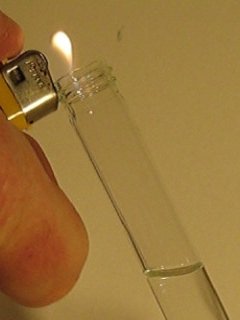 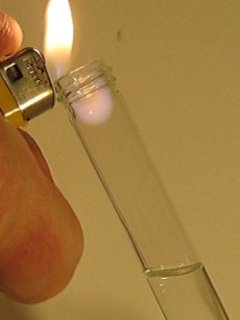 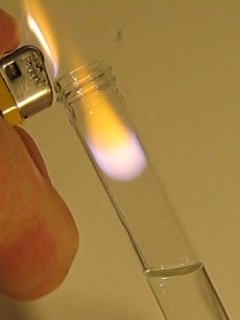
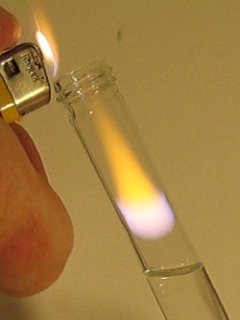 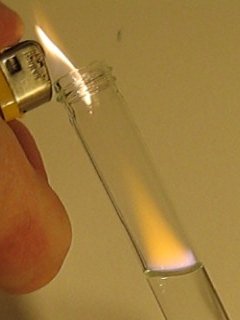 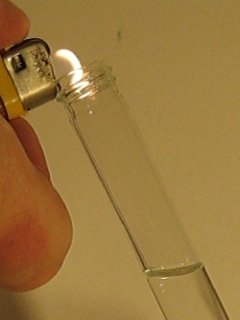
The light from the images is rather yellow, this is because I used a setting at the camera, such that it shows real light color. Tungsten light is
rather yellow, although we don't perceive it is such. The flames in the pics now have true colors, which they have in reality. With color correction,
the color of the flames would become unreliable.
As the pics show, the flame, especially the bottom part, has a very peculiar color. After burning of the gas, no particular smell can be observed, not
the sharp odour, which normally remains after burning chlorinated hydrocarbons. The flame also is not sooty, not at all.
From my (rough) measurements and assuming that the difference between bubbled gas and collected gas is dissolved carbon dioxide, I conclude that
somewhere between 20% and 25% of the anode gas is the flammable gas, the rest is carbon dioxide.
I do not (yet) have a clue what the precise products of electrolyis could be. One thing, however, I can say is that the analogy with normal acetic
acid does not hold. If that analogy existed, then I would expect much more CO2 (two times as much bubbles of anode gas as what I have now) and no
flammable gas (1,2 dichloroethane is a liquid, which boils at 83 C).
EDIT: Changed links such that pictures appear in post again.
[Edited on 29-12-12 by woelen]
|
|
|
not_important
International Hazard
    
Posts: 3873
Registered: 21-7-2006
Member Is Offline
Mood: No Mood
|
|
| Quote: | Resource Relation Sov. Electrochem. (Engl. Transl.) ; Vol/Issue: 22:8; Translated from Elektrokhimiya; 22: No. 8, 1029-1033(Aug 1986)
It was shown by direct comparison of kinetic and adsorption data that at platinum in solutions of mono- and trichloroacetic acid, the anodic processes
are entirely analogous in character to the processes occurring in acetate solutions.^The lack of Kolbe electrosynthesis products in the electrolysis
of chloroacetic acids is to the special reaction features of the secondary chloroalkyl radicals. |
http://www.osti.gov/energycitations/product.biblio.jsp?osti_...
And see attached
Attachment: ELECTROLYTIC CONDENSATION OF CARBOXYLIC ACIDS.pdf (868kB)
This file has been downloaded 1305 times
|
|
|
JustMe
Hazard to Others
  
Posts: 111
Registered: 7-8-2003
Member Is Offline
Mood: No Mood
|
|
Interesting stuff. Going back to an old, old, OLD project of mine... I would be really interested in the results of electrolyzing a sodium saccharin
solution in a U-tube with a gelatin plug on the bottom separating the cathode and anode.
Look up the saccharin anion...
(Taking off the hydrogen from the nitrogen in this picture: http://en.wikipedia.org/wiki/Sodium_saccharin)
I wonder what would happen?
My old time project (mentioned here before), was the study of transitional metal saccharin compounds with the hypothesis that the saccharin anion
would act as a bidentate chelating anion. I made some interesting compounds and grew some interesting crystals. The copper compound(s) (yes, plural)
were very interesting. I was able to grown crystals up to 4 mm or so of the hydrate, and it formed a very interesting green crystaline compound when
dissolved in pure acetone.
My dream (to this day, even though I don't do chemistry anymore), was to react a solution of sodium saccharin with Chromous Sulfate or Chloride (NOT
CHROMIC, the acidity of that solution precipitated free Saccharin) to see if I would get a red compound akin in structure to Chromous Acetate. But
alas, I could never get any Chromous compounds, and the synthesis was too complicated. (Obviously it would have to be in boiled, oxygen-free water
under an inert gas and done quickly, of course.)
Anyway, sorry to go off on a tangent. Looking at the structure of the Saccharin Anion, what do you think would happen if it were electrolysized? Might
be an interesting experiment. Or, to avoid the alkaline of the Sodium, perhaps using a transitional metal compound like Copper Saccharin (precipitates
easily on mixing Cupric Sulfate and Sodium Saccharin... super easy to recrystalize). Hint, hint, LOL.
Enjoy your U-tube in many more experiments!!!
|
|
|
len1
National Hazard
   
Posts: 595
Registered: 1-3-2007
Member Is Offline
Mood: NZ 1 (goal) - Italy 1 (dive)
|
|
Thank you for being one of the few people to continue to post interesting work in this forum! I was quite surprised by Kolbes reaction which you
rediscovered I was quite unaware of it myself. Certainly wouldnt have expected decarboxylation, and impressed you deduced the mechanism of something
Kolbe didnt himself.
Also surprised by the present results. Apparently chloroacetic acids dechlorinate on electrolysis yielding acetic acid. http://www.freepatentsonline.com/4707226.html. Although many patents are rubbish this apparently is not.
I conclude thereupon the acetic acid must electrolyse as before to give CO2 and C2H6 which is what burns - in the now oxygen-rich gas mixture. But
the process competes with the dechlorination, which generates oxygen with the chlorine staying in solution as HCl.
So of the competing processes one generates 1/2 mole of gas at anode per mole at cathode. The other 2 moles per mole at cathode. A ratio of 0.75
lies between these and gives ratio for the two processes. Dissolution of anode is another competing process
[Edited on 24-2-2008 by len1]
|
|
|
Nicodem
Super Moderator
      
Posts: 4230
Registered: 28-12-2004
Member Is Offline
Mood: No Mood
|
|
Very nice experiments, Woelen!
I'm especially fascinated by formate electrolysis since I always wondered what happens to it. Your results indicate that formates/formic acid might be
useful as a sacrificial electrolyte in organic electroreductions where a diaphragm must be used. Such reductions could potentially work without a
diaphragm if an sacrificial electrolyte which does not yield reactive/oxidative species is used.
You could try a preparative aproach of the Kolbe coupling of benzoate and other such carboxylates that would give you liquid or solid products. For
example, you could try getting the paraffin from electrolysis of soap or biphenyl from sodium benzoate…
| Quote: | Originally posted by JustMe
Interesting stuff. Going back to an old, old, OLD project of mine... I would be really interested in the results of electrolyzing a sodium saccharin
solution in a U-tube with a gelatin plug on the bottom separating the cathode and anode. |
This should theoretically yield N-hydroxysaccharin or its nitroxyl, but maybe also something completely different. Seems an interesting
experiment. No diaphragm or gelatin plug is needed since sodium saccharin is an anionic species and thus only reacts at the anode.
[Edited on 24/2/2008 by Nicodem]
…there is a human touch of the cultist “believer” in every theorist that he must struggle against as being
unworthy of the scientist. Some of the greatest men of science have publicly repudiated a theory which earlier they hotly defended. In this lies their
scientific temper, not in the scientific defense of the theory. - Weston La Barre (Ghost Dance, 1972)
Read the The ScienceMadness Guidelines!
|
|
|
not_important
International Hazard
    
Posts: 3873
Registered: 21-7-2006
Member Is Offline
Mood: No Mood
|
|
| Quote: | Originally posted by Nicodem
...
I'm especially fascinated by formate electrolysis since I always wondered what happens to it. Your results indicate that formates/formic acid might be
useful as a sacrificial electrolyte in organic electroreductions where a diaphragm must be used. Such reductions could potentially work without a
diaphragm if an sacrificial electrolyte which does not yield reactive/oxidative species is used. |
Related to that, from the document I included above
| Quote: | Only hydrogen, oxygen, carbon dioxide , and in some instances glycolic acid could be detected in the
electrolysis products of oxalic acid. |
| Quote: |
You could try a preparative aproach of the Kolbe coupling of benzoate and other such carboxylates that would give you liquid or solid products. For
example, you could try getting the paraffin from electrolysis of soap or biphenyl from sodium benzoate… |
Again, from that document, it takes special conditions to get Kolbe dimers from benzoic acids
| Quote: |
For a long time it was assumed that salts of aromatic acids, unlike those of aliphatic acids, did not enter into the Kolbe reaction.
Experiments on the electrolytic condensation of solutions
of salts of benzoic acid in water, sulphuric acid, and absolute methanol, and the electrolysis of fused benzoic acid were indeed unsuccessful. The
reaction products were, in general, benzene, free benzoic acid, oxygen, etc. The same was true of the electrolytic condensation of substituted benzoic
acids such as ο-nitrobenzoic, p-nitrobenzoic, p-toluic, opianic, salicylic, m-hydroxybenzoic, and p-hydroxybenzoic acids, 3,5-dimethyl-and
2,4-dimethylbenzoic acids, and ethyl phthalate.
In the 1930's Fichter et al. refuted the conclusion that aromatic acids do not undergo the Kolbe reaction...aromatic acids can be electrolysed
successfully by using a methanol-pyridine mixture as solvent.
Thus, benzoic, phenylacetic, /3-phenylpropionic, and phenoxyacetic acids yielded the corresponding diphenyl, dibenzyl (50% yield), 1,4-diphenylbutane
(37% yield), and
the diphenyl ester of ethylene glycol (45% yield). |
|
|
|
woelen
Super Administrator
        
Posts: 8035
Registered: 20-8-2005
Location: Netherlands
Member Is Offline
Mood: interested
|
|
@not_important: Thanks for that great PDF. This is an interesting survey of many different reactions. With the Kolbe-synthesis, a complete new world
has opened up to me  . The article only briefly covers the electrolysis of
chloroacetic acid, it tells that chlorine is split off. I will have to think further about this and try to analyse the gas in more detail. One of the
things I intend to do is mixing the gas with dilute bromine vapor. If it is unsaturated, then the color of the bromine vapor will disappear at once. . The article only briefly covers the electrolysis of
chloroacetic acid, it tells that chlorine is split off. I will have to think further about this and try to analyse the gas in more detail. One of the
things I intend to do is mixing the gas with dilute bromine vapor. If it is unsaturated, then the color of the bromine vapor will disappear at once.
@len1: The patent you supply is not applicable to my situation. It describes a cathode reaction, mainly being:
CH2ClCOOH + H(+) + 2e --> CH3COOH + Cl(-)
What I am investigating is the anode reaction. I already got flammable gas and CO2 from the start of the experiment, before any acetic acid could have
formed at the cathode. I also think that the cathode reaction hardly occured in my situation. I measured a current of 150 mA and with this small
current it took almost 25 minutes to fill one test tube of 22 ml with hydrogen gas. This is fairly consistent with formation of almost onloy hydrogen
at the cathode.
|
|
|
BromicAcid
International Hazard
    
Posts: 3254
Registered: 13-7-2003
Location: Wisconsin
Member Is Offline
Mood: Rock n' Roll
|
|
Here is something interesting of note with relation to Kolbe reactions. The radicals produced can attack the metal electrodes to form organometallic
compounds. I found this out when looking through some of the papers on diisopropyl lead. The thread that I made on the subject can be found here:
Easily preparable organometallics and their properties.
This might be interesting to you since the products for lead at least are sometimes brightly colored and separation with something like a U-Tube is
essential to prevent their oxidation.
More information can be found in this PDF which I have hosted on my site. It is from the ACS and is a review of methods of synthesis for organometallic compounds and has it's own
section devoted to radical reactions.
Anyway, figured this might be an interesting extension to what you have already done.
Great work and good luck!
|
|
|
garage chemist
chemical wizard
    
Posts: 1803
Registered: 16-8-2004
Location: Germany
Member Is Offline
Mood: No Mood
|
|
Very nice, woelen! Your extremely good pictures are always something special, as well as your projects.
While it is said that Kolbe electrolysis results in dimerization of the alkyl radicals, this is not always true. The first example is your
chloroacetic acid.
Also, organic chemistry books say that Kolbe electrolysis is unsuitable for aromatic carboxylic acids. This can give very different products than what
one might expect, and also mixtures of products.
Kolbe electrolysis is used industrially to produce sebacic acid (decanedioic acid, the dicarboxylic acid with 10 carbons) from the monomethyl ester of
adipic acid (adipic acid: hexanedioic acid, 6 carbons). The ester group serves as protection, as you can see.
|
|
|
len1
National Hazard
   
Posts: 595
Registered: 1-3-2007
Member Is Offline
Mood: NZ 1 (goal) - Italy 1 (dive)
|
|
Yes I know the patent I mentioned has the reaction at the cathode, still what you are getting is essentially as I outlined before. H2 at the cathode
and mainly O2 at the anode, due to the ratio of cathode to anode gases. You are unlikely to have anything unsaturated in the anode gases because the
anode is an oxidative process - no reduction there. The only possibility for a flamable gas is C2H6 plus traces of haloalkanes, made more so because
of the excess O2 present. So the major anode reaction
H2O -> 2H+ + 1/2O2 + 2e-
minor
CH2ClCOO- + H2O -> CO2 + 1/2O2 + HCl + 1/2C2H6 + e-
The article not important lists does not provide much illucidation unfortunately on the actual details (common problem of review articles) I shall see
if I cna find confirmation elsewhere
[Edited on 25-2-2008 by len1]
|
|
|
PHILOU Zrealone
International Hazard
    
Posts: 2893
Registered: 20-5-2002
Location: Brussel
Member Is Offline
Mood: Bis-diazo-dinitro-hydroquinonic
|
|
Electrochemistry is very surprising indeed...I would have thought you would end up with CH3-Cl or CH3-CH2Cl  but it is not the case. but it is not the case.
Good to know anyway that it is useless to waste good chloracetic salts where cheap acetate provides the same result  . .
PH Z (PHILOU Zrealone)
"Physic is all what never works; Chemistry is all what stinks and explodes!"-"Life that deadly disease, sexually transmitted."(W.Allen)
|
|
|
woelen
Super Administrator
        
Posts: 8035
Registered: 20-8-2005
Location: Netherlands
Member Is Offline
Mood: interested
|
|
Len1, the main reaction I observed at the anode is not production of O2. The gas mix I obtained consists of appr. 80% CO2 (75% to 80% of its volume
is absorbed by a solution of NaOH). The remaining part is a flammable gas, as shown above. Of course, it might contain some O2, but if it contains O2,
this only is a minor part of the anode gas.
I more and more am thinking it is CH3Cl, but I have to think and read a little bit more on this. Further tests also are needed. I certainly will come
back on this, one of these days.
|
|
|
len1
National Hazard
   
Posts: 595
Registered: 1-3-2007
Member Is Offline
Mood: NZ 1 (goal) - Italy 1 (dive)
|
|
That cant be right, even just stoichiometrically
CH2ClCOO- + H+ -> CH3Cl + CO2
So you cant have 80% CO2 if CH3Cl is the only other major product.
Plus the reviews say you get mainly oxidation products and the Cl- splits off. So if you have a significant quantity of CH3Cl youve got publishable
material here!
Also you are not interpreting what is major and minor reactions correctly. The relative contribution of a reaction does not correspond to the volume
of gas generated. Note my first reaction gives 1/2 mole of gas per 2 moles of electrons, whereas the second gives 4 moles of gas for the same 2 moles
of electrons - > i.e. it generates 8 times more gas.
Because of this ratio of gases the ratio of the reactions is very sensitive and cant be judged from a rough estimate of volumes. So I still stand by
my original interpretation.
The only alternative to my reaction 1 would be to consider oxidation of the alkane at the anode by some of the oxygen, instead of it being liberated.
That would correspond to what we know from literature - we get oxidation products.
From the abstract we have that the basic reaction is the same as in Kolbe synthesis with acetate
CH2ClCOO- -> CH2Cl. + CO2 + e-
Now we are told we dont get the usual Kolbe reaction produts, which would be CH3Cl and C2H4Cl2 because the Cl- splits off and the radical oxidizes.
Choices are
CH2O - oxidation 0
C2H4O2 0
CH2O2 +2
C2H2O4 +3
Formaldehyde is much more soluble than CO2 and gives
CH2ClCOO- + H2O -> CH2O + Cl- + 2H+ + CO2 + 2e-
so it can reduce the ratio of cathode:anode gases to 1:1 but gives no flamable gas - so its a possible alternative to the generation of pure oxygen
-> You can test for formaldehyde in the water, but you must still have my reaction 2.
Acetic acid formation would lead to some of it being immediately oxidized further, overall reaction as in my reaction 2.
Further oxidation gives formic acid
CH2ClOO- + 2H2O -> HCOOH + Cl- + CO2 + 4H+ + 4e-
this reduces the ratio of cathode:anode gases to 2:1, same as my reaction 1. Can be tested by presence of formic acid, but you must still have my
reaction 2.
Your suggestion
CH2Cl. + H+ + e- -> CH3Cl
is a reduction, which I think is very unlikely at the anode, still you can test for the presence of HCl in the burnt gases with moist indicator paper
(stronger effect than H2CO3) or - a spatula with a drop of NH3 solution held in the exhaust gases will fume strongly. Even if by some miracle this
reaction were to occur, it can only be a minor reaction as I pointed out above. Add to that that it liberates no net electrons, and we know something
must oxidize at the anode, at the rate at which H2 is reduced at the cathode.
I cant unfortunately get to the first article not important posted because my institution doesnt receive it.
[Edited on 26-2-2008 by len1]
|
|
|
woelen
Super Administrator
        
Posts: 8035
Registered: 20-8-2005
Location: Netherlands
Member Is Offline
Mood: interested
|
|
I have been thinking about this, and the following could come quite close to my observations:
First reaction: 2CH2ClCOO(-) - 2e --> 2CH2ClCOO•
At the cathode, we then have a single molecule of H2.
Now suppose the radical CH2ClCOO• decomposes: 2CH2ClCOO• --> 2CH2Cl• + 2CO2
Now for 1 molecule of H2 we have two molecules of CO2.
The radicals CH2Cl• could react as follows: 2CH2Cl• + H2O --> CH3Cl + CH2Cl(OH).
The latter compound is unstable and would immediately split off HCl, which goes into solution as hydrated H(+) and Cl(-). The organic compound, which
remains behind is CH2O.
CH2O is a strong reductor. At the anode it would be oxidized as follows (net reaction, no mechanism presented here):
CH2O + H2O - 2e --> HCOOH + 2H(+).
So, at the cathode there is no gas for this reaction, at the anode we have another molecule of H2. Now we have 2H2 at the cathode for 2CO2 + CH3Cl at
the anode.
Things can go further (see my webpage on oxidation of HCOOH at the start of this thread):
HCOOH - 2e --> CO2 + 2H(+)
No we have another molecule of CO2 at the anode and again a molecule of H2 at the cathode.
The reason why I believe these reactions could occur is that the compounds CH2O and HCOOH are formed directly at the anode. So, they are at
the right place for immediate further oxidation. This is not the case for some compounds, formed at the cathode, which first need time to move to the
anode.
This makes for a ratio of gases as follows: cathode : anode = 3H2 : (3CO2 + CH3Cl), which makes a volume ratio Vcathode : Vanode = 3 : 4.
I also noticed a strong smell at the anode of chlorine. The liquid become green/yellow, but hardly any chlorine gas made it into the gas phase (it
dissolves quite well).
The net reaction for one Cl(-) is:
Cl(-) - e --> 1/2 Cl2 (which is assumed to remain dissolved almost 100%). This makes the volume ratio of gases Vcathode : Vanode = 3.5 : 4
Besides the reaction, mentioned above, there undoubtedly also will be formation of O2 at the anode. That would bring the volume of anode gas, compared
to cathode gas even further down. I can come close to the observed approximate 1 : 1 ratio of bubbled gas. Dissolving of CO2 in water can explain the
lower amount of collected anode gas.
So, what I have written down is just some theory, and I do not present it as the truth. I'll do the test, suggested by len1. I again make some of the
flammable gas and let it burn and see whether it produced smoke with 25% NH3 around, near the rim of the test tube. That indeed is a very sensitive
test for HCl, which would be formed by burning CH3Cl. If this test is negative, then my theory does not hold anymore and further searching is
required. If the test is positive, then it does not prove my theory, but it again is evidence, supporting it.
|
|
|
YT2095
International Hazard
    
Posts: 1091
Registered: 31-5-2003
Location: Just left of Europe and down a bit.
Member Is Offline
Mood: within Nominal Parameters
|
|
I`m wondering if perhaps a soln of acidic silver nitrate added to the gas tube (before ignition) and then shaken around a bit may also show the
presence of Cl?
\"In a world full of wonders mankind has managed to invent boredom\" - Death
Twinkies don\'t have a shelf life. They have a half-life! -Caine (a friend of mine)
|
|
|
len1
National Hazard
   
Posts: 595
Registered: 1-3-2007
Member Is Offline
Mood: NZ 1 (goal) - Italy 1 (dive)
|
|
Combining what you wrote is completely equivalent to my oxidation to formic acid above
CH2ClOO- + 2H2O -> HCOOH + Cl- + CO2 + 4H+ + 4e-
together with the CH3Cl generation equation
CH2ClCOO- + H+ -> CH3Cl + CO2
Your provide a plausibility argument for linking these two reactions in a 1:1 ratio, the link lies in you combining two alkyl chloride radicals in the
one formula as you did
2CH2Cl• + H2O --> CH3Cl + CH2Cl(OH)
so that one molecule goes the first (oxidative way) the other the second (reductive way). This is where the essence of what you are saying lies.
Because the second reaction is local, you can add any amount of it to the real oxidation correponding to the first reaction and still have a valid
cell. Experiment has to decide, but I still think that CH3Cl is a reduction which seems unlikely, and it goes against what the literature says. IF
your tests show thats what you actually get, youve got publishable material I think.
I dont think shaking a chloroalkane with AgNO3 will work well as the Cl is covalently bonded and so the concetration of free Cl- is likely to be well
below that required by the AgCl solubility product.
[Edited on 26-2-2008 by len1]
|
|
|
YT2095
International Hazard
    
Posts: 1091
Registered: 31-5-2003
Location: Just left of Europe and down a bit.
Member Is Offline
Mood: within Nominal Parameters
|
|
| Quote: | Originally posted by len1
I dont think shaking a chloroalkane with AgNO3 will work well as the Cl is covalently bonded and so the concetration of free Cl- is likely to be well
below that required by the AgCl solubility product.
[Edited on 26-2-2008 by len1] |
it may do Post Ignition though!
\"In a world full of wonders mankind has managed to invent boredom\" - Death
Twinkies don\'t have a shelf life. They have a half-life! -Caine (a friend of mine)
|
|
|
woelen
Super Administrator
        
Posts: 8035
Registered: 20-8-2005
Location: Netherlands
Member Is Offline
Mood: interested
|
|
I have done more tests now with a new cell and fresh materials.
I have done a test in order to obtain more precise data on the volume ratio in which gases are produced. I have done this, by first letting the
electrolysis run for half an hour or so, then blowing out all gas mixes from the tubing, getting only air in the apparatus. The bubbles of gas from
the cathode and anode now are air bubbles and there is much less error due to dissolving of the gases. With this test, I found a volume ratio as
follows:
Vcathode : Vanode = 90 : 125 (which is very close to 3 : 4)
Another test was done in order to see whether a cathode side reaction occurs, besides the production of hydrogen gas.
I had two experiments:
23.5 ml of gas was produced in 1110 seconds, the current was 0.24 A, the air temperature was 14 C, the test tube with gas was wet and probably was
slightly colder due to evaporation of water. Let's say 10 C.
Total amount of gas, produced per second is 0.24/96485/2*(283/300)*22400 ml = 0.0263 ml
Filling a test tube of 23.5 ml with this gas would take 23.5/0.0263 = 893 seconds. Measured time is 1110 seconds. So, appr. 20% of all electrons go
into another reaction, than the reaction of making H2.
After running the cell for more than an hour, the liquid becomes warm, and at that time I did another test. Now the current was 0.30 A. With that
current one would expect the same test tube to be filled in 715 seconds. Measured time now is 770 seconds. Now, more than 90% of all electrons from
the cathode go into production of H2 and the side reaction is much less pronounced.
The ratio of flammable gas to CO2 remains the same for all experiments, it is appr. 1 : 4, so the anode reactions seem to be fairly constant during
the experimenting. The only difference is that after some time, a faint green color of Cl2 can be observed.
This is the quantitative part. Now the qualitative part. The flammable gas is not an olefin, in the later stages of the experiment, the bubbles of
this gas have a faint smell of elemental chlorine. This would be absolutely impossible if there were unsaturated C=C bonds in the gas mix.
I also did tests about the chlorine contents of the gas mix. First, it is shaken with ammonia, in order to destroy any traces of elemental chlorine
from the gas mix and to absorb CO2 from the mix. The ammonia contents in the test tube is appr. 3% and then a gas-air mix (1 : 1) is ignited. No
traces of ammonium chloride could be observed, nothing at all.
In another test, the gas mix is cleaned with a solution of NaOH and then it is mixed with air again and the gas mix is ignited, with 15% ammonia just
a few cm from the opening of the test tube. Again, no smoke of NH4Cl could be observed. I now am convinced, the gas does not contain chlorine, and
hence it is not CH3Cl. Len1, you were right, at least with this aspect of the reaction.
Time to think more about this.....
The only flammable gases I can imagine as plausible alternatives now arre CH4 and CH3CH3.
[Edited on 26-2-08 by woelen]
|
|
|
woelen
Super Administrator
        
Posts: 8035
Registered: 20-8-2005
Location: Netherlands
Member Is Offline
Mood: interested
|
|
The appearance of the flame is quite similar to the pics when made in daylight. The preceived color is more blue instead of rose. This probably is due
to the white background, instead of the yellow background light.
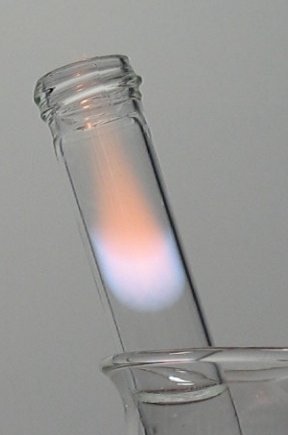
When the gas was cleaned with ammonia, then the flame appeared different. No orange flame above the blue flame. I doubt that this is due to the
ammonia. More likely, this sample has a little bit more air mixed in, but for completeness I'll post this picture as well.
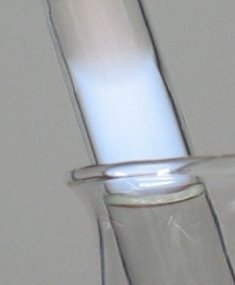
EDIT: The flame color and shape looks a little bit like the flame, produced by CO. I made some CO by mixing 85% formic acid with concentrated
sulphuric acid and them mixed this with air and ignited. The result looks somewhat like the flame, shown in the ammonia picture, without the orange
tinge.
[CO] could be produced according to the following formal model (only formal, specifying level of oxidation of C):
CH2ClCOO(-) - e --> CH2ClCOO•
Half a molecule of H2 is produced at cathode.
Splitting up of radical, with splitting off of the chlorine as HCl.
CH2ClCOO• --> [CH] + HCl + CO2
Here [CH] stands for a formal species, C has oxidation state -1.
[CH] - e --> [C] + H(+)
Another half molecule of H2 is produced at the cathode.
[C] + H2O - 2e --> CO + 2H(+)
Another molecule of H2 is produced at the cathode.
An alternative reaction is
[C] + 2H2O - 4e --> CO2 + 4H(+)
With this, two molecules of H2 are produced at the cathode.
Using this formal model, I can explain a mix of CO and CO2 as anode gases, and a Vanode : Vcathode ratio between 1 : 1 and 1 : 1.5. Pure CO2 would
result in a 1 : 1.5 volume ratio, a mix of equal volumes of CO and CO2 would result in a 1 : 1 volume ratio.
The observed ratio of CO and CO2 is somewhere between 1 : 3 and 1 : 4, this would result in a ratio Vanode : Vcathode ≈ 1 : 1.2.
If one takes into account that the cathode reaction also is not 100%, but between 80 and 90%, then the ratio will be closer to 1 : 1 again.
This could be an explanation for the reaction. More testing now is needed. Is there an easy to apply test for CO?
EDIT: Changed links, so that pictures appear in post again.
[Edited on 24-6-13 by woelen]
|
|
|
| Pages:
1
2 |
|